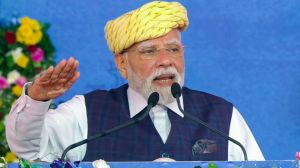Bollywood and the God of Wisdom
For all the devotion to Lord Ganesha that film stars express, the Elephant God has had only a minimal presence in Bollywood. Why otherwise c...

For all the devotion to Lord Ganesha that film stars express, the Elephant God has had only a minimal presence in Bollywood. Why otherwise can’t one think of even ten memorable scenes projecting the God of Wisdom?
One remembers a passing shot in Filmwala’s Kalyug. A disturbed Shashi Kapoor gets caught in festival traffic. The chaos around him reflects the upheaval in his life. In Takkar, the villains conceal the temple loot inside the idol. They are hoping to escape with it but are confronted by the heroic team of Jeetendra, Shatrughan Sinha and Sanjeev Kumar. The song,‘Murti Ganesh ki, andar daulat desh ki’ has the usual ‘good conquers evil’ message. Humse Badkar Kaun essayed middle-class families celebrating the festival together. The haunting ‘Deva ho deva’ is chanted even today at the pandals.
Ajanta Arts’ Dard Ka Rishta dwelt upon a young girl’s devotion to the deity. Baby Khushboo, a terminally-ill patient, is in coma but even in her semi-conscious state she hears echoes of the Lord coming home. To fulfill the dying girl’s wish, her father carries the idol to the hospital and she dies in peace! In Mukul Anand’s Agneepath, the underworld don is from Mandva, a small Goan village. His family worships Ganesha and even when the hero has become estranged from his roots, his faith remains undiminished. Starring Amitabh Bachchan as the man trapped in the system, the film showcased a dramatic climax where the protagonist is stabbed amid crowds while carrying the idol for immersion. The message is that even the most faithful devotee has to pay for his karma. There were similar glimpses in Satya, when the police drag the hero from the procession. Regarded as a robust festival exuding boundless energy, cinema used it to portray emotions like pathos, triumph, conflict, courage. In Dil To Pagal Hai, Shah Rukh Khan and Madhuri Dixit are unable to express their love, so dance teacher Aroona Irani gifts them Ganesha idols hoping that they will muster the courage to do so.
By and large, however, mainstream Hindi cinema has failed to make a hero out of Ganesha. And this was largely because no popular hero was able to single out the deity for his screen image. Dilip Kumar always addressed his woes to Lord Shiva (Amar, Dil Diya Dard Liya); Mehmood confided his problems to Lord Hanuman, fondly addressed as Bajrangbali and Meena Kumari cried before Lord Krishna (Main Chup Rahungi, Kaajal). While films like Deewar addressed a soliloquy from the anguished hero to Shiva or Maalik, Yehi Hai Zindagi and Mr Natwarlal delineated a conversation between the Lord and the hero, no filmmaker has attempted to immortalise Ganesha.
It’s difficult to explain why this is the case. Perhaps it is because north Indians dominate Bollywood, or it could be because Shiva symbolised virility and was considered a fitting idol for the hero, while Hanuman was a perfect image for the supporting actor for his loyalty to Ram. Similarly, Goddess Kali and Goddess Durga were worshipped when heroines were oppressed.
Legend has it that Ganesha was beheaded by his furious father who repented his mistake and replaced his head with that of an elephant’s. Call it an extension of the same curse, but despite Lord Ganesha’s dynamism cinema has failed to wholeheartedly celebrate him on screen. It’s time, perhaps, for our script writers to give this some serious thought.
Photos



- 01
- 02
- 03
- 04
- 05




























